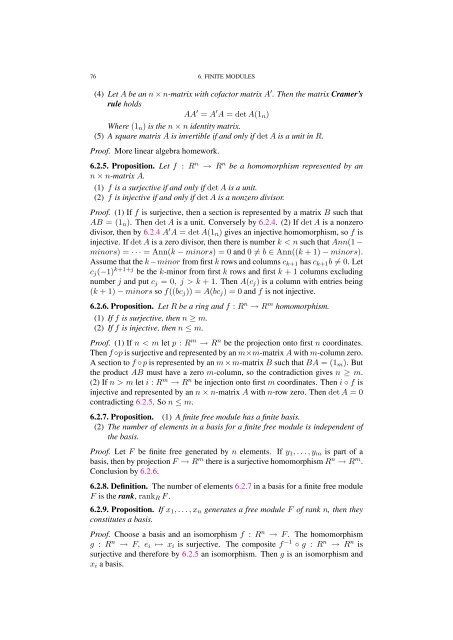Commutative algebra - Department of Mathematical Sciences - old ...
Commutative algebra - Department of Mathematical Sciences - old ...
Commutative algebra - Department of Mathematical Sciences - old ...
Create successful ePaper yourself
Turn your PDF publications into a flip-book with our unique Google optimized e-Paper software.
76 6. FINITE MODULES<br />
(4) Let A be an n × n-matrix with c<strong>of</strong>actor matrix A ′ . Then the matrix Cramer’s<br />
rule h<strong>old</strong>s<br />
AA ′ = A ′ A = det A(1n)<br />
Where (1n) is the n × n identity matrix.<br />
(5) A square matrix A is invertible if and only if det A is a unit in R.<br />
Pro<strong>of</strong>. More linear <strong>algebra</strong> homework.<br />
6.2.5. Proposition. Let f : R n → R n be a homomorphism represented by an<br />
n × n-matrix A.<br />
(1) f is a surjective if and only if det A is a unit.<br />
(2) f is injective if and only if det A is a nonzero divisor.<br />
Pro<strong>of</strong>. (1) If f is surjective, then a section is represented by a matrix B such that<br />
AB = (1n). Then det A is a unit. Conversely by 6.2.4. (2) If det A is a nonzero<br />
divisor, then by 6.2.4 A ′ A = det A(1n) gives an injective homomorphism, so f is<br />
injective. If det A is a zero divisor, then there is number k < n such that Ann(1 −<br />
minors) = · · · = Ann(k − minors) = 0 and 0 = b ∈ Ann((k + 1) − minors).<br />
Assume that the k−minor from first k rows and columns ck+1 has ck+1b = 0. Let<br />
cj(−1) k+1+j be the k-minor from first k rows and first k + 1 columns excluding<br />
number j and put cj = 0, j > k + 1. Then A(cj) is a column with entries being<br />
(k + 1) − minors so f((bcj)) = A(bcj) = 0 and f is not injective.<br />
6.2.6. Proposition. Let R be a ring and f : R n → R m homomorphism.<br />
(1) If f is surjective, then n ≥ m.<br />
(2) If f is injective, then n ≤ m.<br />
Pro<strong>of</strong>. (1) If n < m let p : R m → R n be the projection onto first n coordinates.<br />
Then f ◦p is surjective and represented by an m×m-matrix A with m-column zero.<br />
A section to f ◦ p is represented by an m × m-matrix B such that BA = (1m). But<br />
the product AB must have a zero m-column, so the contradiction gives n ≥ m.<br />
(2) If n > m let i : R m → R n be injection onto first m coordinates. Then i ◦ f is<br />
injective and represented by an n × n-matrix A with n-row zero. Then det A = 0<br />
contradicting 6.2.5. So n ≤ m.<br />
6.2.7. Proposition. (1) A finite free module has a finite basis.<br />
(2) The number <strong>of</strong> elements in a basis for a finite free module is independent <strong>of</strong><br />
the basis.<br />
Pro<strong>of</strong>. Let F be finite free generated by n elements. If y1, . . . , ym is part <strong>of</strong> a<br />
basis, then by projection F → R m there is a surjective homomorphism R n → R m .<br />
Conclusion by 6.2.6.<br />
6.2.8. Definition. The number <strong>of</strong> elements 6.2.7 in a basis for a finite free module<br />
F is the rank, rankR F .<br />
6.2.9. Proposition. If x1, . . . , xn generates a free module F <strong>of</strong> rank n, then they<br />
constitutes a basis.<br />
Pro<strong>of</strong>. Choose a basis and an isomorphism f : R n → F . The homomorphism<br />
g : R n → F, ei ↦→ xi is surjective. The composite f −1 ◦ g : R n → R n is<br />
surjective and therefore by 6.2.5 an isomorphism. Then g is an isomorphism and<br />
xi a basis.
















